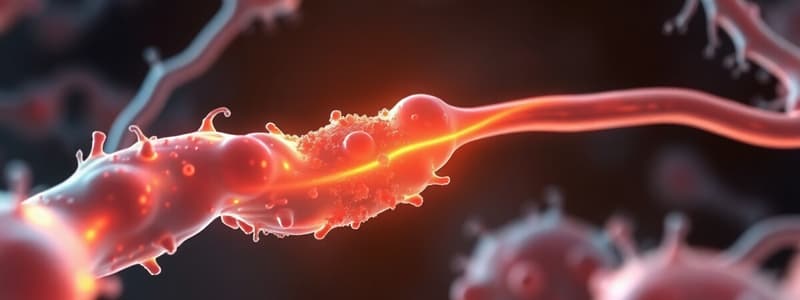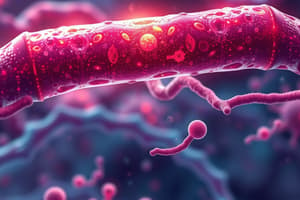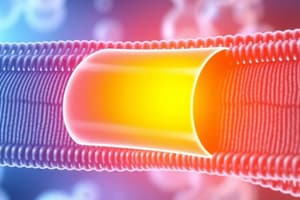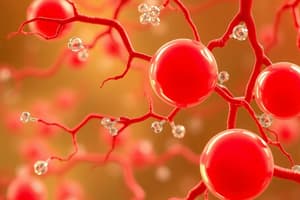Podcast
Questions and Answers
Which of the following is the primary function of GLUT-2 transporters in pancreatic beta cells?
Which of the following is the primary function of GLUT-2 transporters in pancreatic beta cells?
- To facilitate the transport of insulin out of the cell.
- To regulate the activity of glucokinase within the cell.
- To directly phosphorylate glucose into Glucose-6-Phosphate.
- To enable glucose to enter the cell, initiating insulin release. (correct)
What is the role of glucokinase (GK) in both hepatocytes and pancreatic beta cells?
What is the role of glucokinase (GK) in both hepatocytes and pancreatic beta cells?
- It transports glucose across the cell membrane.
- It converts glycogen into glucose-6-phosphate.
- It phosphorylates glucose to form glucose-6-phosphate, trapping it inside the cell. (correct)
- It regulates the release of insulin from storage granules.
What is the immediate consequence of ATP build-up within pancreatic beta cells due to glucose metabolism?
What is the immediate consequence of ATP build-up within pancreatic beta cells due to glucose metabolism?
- Opening of voltage-sensitive calcium channels.
- Closing of potassium channels. (correct)
- Increased glycogen synthesis.
- Activation of glucokinase.
How does the liver respond to high glucose levels after a meal?
How does the liver respond to high glucose levels after a meal?
What is the role of Lipoprotein Lipases (LL) in the context of VLDL and adipocytes?
What is the role of Lipoprotein Lipases (LL) in the context of VLDL and adipocytes?
Under low glucose conditions, what is the function of Glucokinase Regulatory Protein (GKRP) in hepatocytes?
Under low glucose conditions, what is the function of Glucokinase Regulatory Protein (GKRP) in hepatocytes?
What triggers the release of insulin from pancreatic beta cells?
What triggers the release of insulin from pancreatic beta cells?
Which of the following represents the correct sequence of events in the liver during high glucose conditions?
Which of the following represents the correct sequence of events in the liver during high glucose conditions?
What is the key difference in GLUT-2 transporter location in enterocytes under normal versus high glucose concentrations?
What is the key difference in GLUT-2 transporter location in enterocytes under normal versus high glucose concentrations?
Which metabolic pathway does glucose-6-phosphate (Glu-6-P) NOT directly enter in hepatocytes?
Which metabolic pathway does glucose-6-phosphate (Glu-6-P) NOT directly enter in hepatocytes?
Snare proteins have an important role in the pancreatic beta cells. What is it?
Snare proteins have an important role in the pancreatic beta cells. What is it?
Following glycolysis, pyruvate can be converted to Acetyl-CoA to enter the Krebs Cycle. In the liver, what is a possible fate of citrate produced during the Krebs cycle?
Following glycolysis, pyruvate can be converted to Acetyl-CoA to enter the Krebs Cycle. In the liver, what is a possible fate of citrate produced during the Krebs cycle?
Considering all the roles of Glucokinase: In which of the following tissues is Glucokinase NOT crucial for glucose regulation?
Considering all the roles of Glucokinase: In which of the following tissues is Glucokinase NOT crucial for glucose regulation?
VLDL transports synthesized triglycerides to fat. What happens to the constituent parts of triglycerides after VLDL interacts with lipoprotein lipase (LL) on endothelial cells?
VLDL transports synthesized triglycerides to fat. What happens to the constituent parts of triglycerides after VLDL interacts with lipoprotein lipase (LL) on endothelial cells?
Which of the following statements BEST describes the interplay between GLUT-2 and glucokinase in glucose homeostasis?
Which of the following statements BEST describes the interplay between GLUT-2 and glucokinase in glucose homeostasis?
Flashcards
GLUT-2
GLUT-2
A glucose transporter with low affinity for glucose, found in liver, pancreas, GIT, and nephrons.
Enterocytes
Enterocytes
Epithelial cells lining the inner surface of the small and large intestines
GLUT-2 in High Glucose
GLUT-2 in High Glucose
In high glucose concentrations, GLUT-2 is present on the apical membrane to facilitate glucose absorption from the small intestine.
Pancreatic Beta Cells
Pancreatic Beta Cells
Signup and view all the flashcards
Glucokinase
Glucokinase
Signup and view all the flashcards
Glucose Sensor
Glucose Sensor
Signup and view all the flashcards
GKRP (GK Regulatory Protein)
GKRP (GK Regulatory Protein)
Signup and view all the flashcards
VLDL
VLDL
Signup and view all the flashcards
Lipoprotein Lipases
Lipoprotein Lipases
Signup and view all the flashcards
Glycogen Storage
Glycogen Storage
Signup and view all the flashcards
Study Notes
- GLUT-2 has a weak affinity for glucose, with a Km of 15 mM
- GLUT-2 is found in beta cells of the pancreas, liver, gastrointestinal tract (GIT), and nephrons.
GLUT-2 in Enterocytes
- Mucosal cells are a general term, while enterocytes are a specific type of mucosal cell.
- GLUT-2, along with GLUT-1, is used in enterocyte cells of the small intestine on the basolateral side to help glucose move to the blood.
- When glucose concentration is high in the lumen (around 30mM), GLUT-2 channels are also present on the apical membrane to facilitate glucose diffusion from the small intestine into the cell.
GLUT-2 in Pancreas Beta Cells
- Beta cells are clustered in the pancreas, surrounded by alpha cells, with delta cells scattered around.
- Beta cells release insulin when blood glucose levels rise.
- Glucose diffuses into beta cells through GLUT-2 channels.
- Glucokinase phosphorylates glucose, preventing it from leaving the cell; GLUT-2 and glucokinase together form a glucose sensor.
- Glucokinase converts glucose into glucose-6-phosphate, which is irreversible.
- Glucose-6-phosphate is converted into pyruvate through glycolysis, and pyruvate enters the Krebs cycle in the mitochondria to produce ATP.
- ATP plugs K+ pumps, causing K+ buildup and cell depolarization.
- Depolarization opens voltage-sensitive Ca2+ channels, bringing Ca2+ into the cell.
- Ca2+ modifies surface proteins of insulin storage granules (ISG) and their receptors on the cell membrane, bringing them together.
- Snare proteins on the ISG surface facilitate the movement of the ISG towards the cell membrane.
- The ISG fuses to the membrane and releases insulin into the blood.
GLUT-2 in the Liver
- Insulin sensors on the hepatocyte surface capture insulin.
- Stimulation of these receptors activates genes that stimulate glucokinase activity.
- When glucose levels are low, glucokinase regulatory protein (GKRP) grabs glucokinase and moves it to the nucleus.
- When glucose levels rise, some glucose goes to the nucleus and causes glucokinase to leave the nucleus and phosphorylate glucose.
- Glucose entering the hepatocyte is immediately phosphorylated and converted into glucose-6-phosphate by glucokinase.
- Glucose-6-phosphate can proceed through three different pathways: conversion into glycogen until glycogen stores are full (about 10% of liver weight), conversion into hexose-monophosphate-shunt, or glycolysis to become pyruvate.
- Pyruvate undergoes the Krebs cycle, resulting in citrate.
- G6P → Glyceraldehyde 3 Phosphate → Pyruvate → Adenyl coA → Citrate
- Citrate goes to the cytosol and is converted back to acetyl-CoA, which binds to create long carbon chains that become fatty acids.
- Three fatty acids bind with glycerol (from glyceraldehyde) to create triglycerides.
- Triglycerides are packed into special proteins and thrown into the blood as VLDL (Very Low-Density Lipoprotein).
- Lipoprotein lipases on the endothelium of blood vessels strip fatty acids from triglycerides as VLDL passes by.
- Glycerol and fatty acids are separately absorbed into adipocytes (fat cells).
Glucokinase Location
- Glucokinase is found in hepatocytes (glucose storage), pancreatic beta cells (assists in the release of insulin), and the hypothalamus (glucose sensors, especially in hypoglycemic situations).
Studying That Suits You
Use AI to generate personalized quizzes and flashcards to suit your learning preferences.




